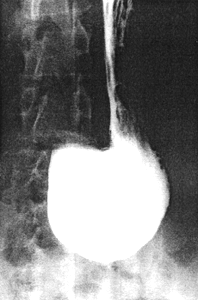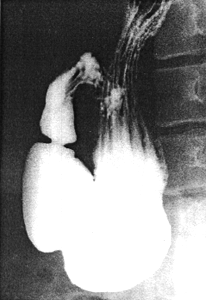



Go to chapter: 1 | 2 | 3 | 4 | 5 | 6 | 7 | 8 | 9 | 10 | 11 | 12 | 13 | 14 | 15 | 16 | 17 | 18 | 19 | 20 | 21 | 22 | 23 | 24 | 25 | 26 | 27 | 28 | 29 | 30 | 31 | 32 | 33 | 34 | 35 | 36 | 37 | 38 | 39
Chapter 20 (page 90)
Fifty adult, ambulatory out-patients, each showing a long, "hanging", atonic stomach
with a marked delay in gastric emptying of liquid barium in the erect position (an
appearance usually ascribed to pylorospasm), were selected for examination. These
patients were encountered during the ordinary course of events, having been referred for
routine radiographic study because of vague upper abdominal symptoms. None had any
objective signs of upper gastrointestinal disease at a prior clinical examination. The
following is a representative case:
Case 20.1.J.B., 47 year old male. After swallowing the first 3 mouthfuls of
Micropaque in the erect position, the stomach was seen to be of the long, hanging, atonic
type, the sagging greater curvature forming the most dependent part (Fig.
20.1A). The distal part of the stomach curved upwards and was filled up to
the presumed position of the pyloric ring. Peristalsis and cyclical contractions of the
pyloric sphincteric cylinder were absent, with total absence of gastric emptying for the
first 5 minutes. This would have been interpreted as "pylorospasm" by many
investigators. The head of the examining table was then lowered to an angle of 45
degrees, while the patient was rotated 45 degrees onto the right side (i.e. the tilted left
anterior oblique radiological position). Immediate emptying of liquid barium occurred in
the continued absence of both peristalsis and contractions of the pyloric sphincteric
cylinder, revealing a normal pyloric ring surrounding a patent aperture (Fig
21.1B). On re-assuming the erect position, gastric emptying ceased once
again.
A | B |
| Fig. 20.1. A
Case J.B. Erect position. Long, atonic stomach, the sagging
greater curvature forming most dependent part. Absence of peristalsis, cyclical activity
of sphincteric cylinder and emptying of fluid barium.
B Case J.B. Oblique tilted position. Normal pyloric ring and
patent aperture. Immediate emptying of fluid barium in continued absence of peristalsis
and cyclical activity of sphincteric cylinder
|
In 49 of the patients the features were identical to the case quoted. The findings show
that the delay in gastric emptying was not due to pylorospasm, in the sense that the
pyloric ring was spastic, as neither spasm nor delayed emptying was present in the tilted
oblique position; it would be highly improbable for spasm to manifest itself in the erect
position only. It was much more likely that the delay in gastric emptying was due to one
or both of the following factors: (1) primarily aperistaltic, hypotonic stomach; (2) the
erect position of the subject. In these cases, in the erect position, the pyloric aperture is at
a higher level than the lowermost part of the greater curvature, which bulges downward.
While the aperture is patent, the lack of tone (Chap. 19) and/or cyclical contractions of
the pyloric sphincteric cylinder (Chap. 18) causes failure of emptying. In the tilted
oblique position the aperture is manipulated so as to become the lowermost part of the
stomach. While contractions of the cylinder remain absent, passive, gravitational
emptying of liquid content occurs, showing the aperture to be patent, without evidence of
spasm of the ring. (In one of the 50 cases a delay in gastric emptying occurred in both
the erect and the tilted oblique positions; the cause of this remained unclear.)
It appears possible that Hughson (l925), Deaver and Burden (l929) and others were led to
believe that absent or delayed emptying of fluid barium in hypotonic stomachs in the
erect position, was due to pylorospasm, which was equated with spasm of the pyloric
ring. It was claimed, moreover, that such "pylorospasm" was a frequent accompaniment
of intra-abdominal pathology. In the historical context it is of interest to note that
Bastianelli (l925) questioned their radiological interpretation of "pylorospasm". Even
today an inactive, hypotonic, barium containing stomach showing delayed or absent
emptying in the erect position is often, and we believe mistakenly, ascribed to
pylorospasm. According to Torgersen's views (l942) it would be highly unlikely for the
pyloric ring (the right pyloric loop) as such, to become spastic; as no dividing line exists
between the musculature of the ring and that of the remainder of the sphincteric cylinder,
any possible spasm would involve the entire cylinder.
Previous Page | Table of Contents | Next Page
© Copyright PLiG 1998








